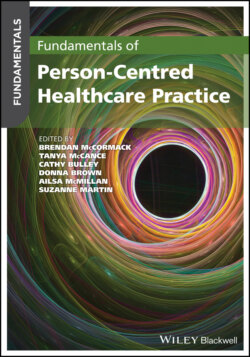Читать книгу Fundamentals of Person-Centred Healthcare Practice - Группа авторов - Страница 44
Activity
ОглавлениеImagine you are ‘the Osclean’ Caitlin has written to. What would your response be to her regarding your expectation of your care? Does what she says sound interesting? Would you want to be a part of it – why/why not? Are there things missing from Caitlin's description that you would want to be included? Feel free to present your response in any creative way you are drawn to.
As Caitlin recognises in her reflection, consideration of the person and our understanding of personhood in the context of how we relate to each other have a long tradition in philosophy and you have been introduced to some of these perspectives in Chapter 1. In more contemporary theory, the term ‘person‐centred’ is often considered to originate from the work of Carl Rogers and his humanistic psychological and person‐centred therapy (Rogers 1961). Rogers' focus was on maximising our potential to fulfil our personal life goals, including our need to be autonomous, social, connected with and respected by others, i.e. to be known as a person.
Drawing on all of these traditions, we can summarise being person‐centred as implying the recognition of the broad biological, social, psychological, cultural and spiritual dimensions of each person (i.e. the whole person) in our ways of being and doing as persons.
The core principles of person‐centredness can be seen in an array of models and frameworks applied to different health conditions (for example, Parkinson's disease [Buetow et al. 2016]), different client groups – where the most concentrated work has happened with persons living with dementia (see for example Fazio et al. 2018), and different healthcare settings, for example in critical care units (see for example van Mol et al. 2016). In the context of psychiatric medicine, for example, Mezzich et al. (2009) suggest that person‐centredness can be seen to be operationalised within four dimensions of practice: (i) care of the person (of the totality of the person's health, including its negative and positive aspects), (ii) care for the person (promoting the fulfilment of the person's life project), (iii) care by the person (with clinicians extending themselves as full human beings with high ethical aspirations) and (iv) care with the person (working respectfully, in collaboration and in an empowering manner).
However, we would suggest that these perspectives of person‐centredness are myopic and exclusive – what do we mean by that? Earlier we described the core values that underpin person‐centredness and we highlighted the importance of these values applying to all persons, not just persons using health services. It therefore follows that these values also apply to persons who are directly providing, managing, co‐ordinating, funding and planning services. So when we think about person‐centred practice, we have to think about it in the context of all persons. It is not enough to just think about person‐centred practice in the context of ‘doing practice’ but we also need to think about it in the context of our ‘being’ as a person working in healthcare and how we relate to all other persons, and how they relate to us. In addition, we showed in Chapter 1, through an analysis of the work of Leibing (2008) and Smith (2003), that person‐centred practice cannot depend solely on the values of individual practitioners and their commitment to working in this way. Smith shows clearly that the prevailing moral values in particular cultures have a significant influence on our ability to work in this way, and so presenting person‐centredness from the lens of ‘quality of care experienced by service users’ is a necessary but insufficient approach to person‐centredness. What we need to think about is the continuous development of cultures that can create, nurture, support and reflexively evaluate person‐centredness in the everyday experiences of all persons.
